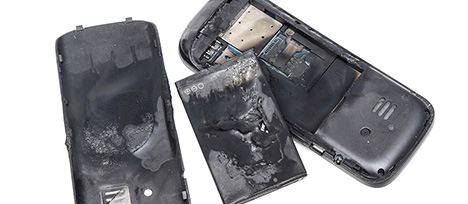
Nov. 3, 2016
Aviation is safer than it’s ever been, but two risks are increasing: drone strikes and battery fires. “Those are the only two incidents going up,” said John Cox, CEO of Safety Operating Systems, at an NBAA-BACE education session in the Innovation Zone, which was added as a late, “pop-up” session to the agenda to address this timely issue with attendees.
The Samsung Note 7, the device banned from flight by the FAA, is “only a symptom of a problem with all lithium ion batteries,” Cox told the standing-room-only crowd. “We’re flying more and seeing more devices on airplanes. It’s going to come up again.”
There’s no way to predict when a thermal runaway is going to occur, igniting a lithium battery fire. A thermal runaway starts from an internal short that may be caused by a manufacturing defect, physical damage or heat.
Unexpectedly Dangerous
A phone may be small, but the safety risks from its battery can spread quickly throughout an airplane. And lithium batteries are also used in laptops, tablets and most rechargeable devices.
“In an inflight environment, we’re not only going to have to deal with fire, the resultant damage and smoke, but also panic,” said Cox.
Rechargeable batteries contain a lithium ion gel. The gel is sticky, and its heats to about 1,000 degrees Fahrenheit in a thermal runaway, so it results in immediate second-degree burns. “People nearby are in harm’s way,” said Cox. “It’s bad enough if the firefighter is a flight attendant, what if it’s a pilot?”
A lithium battery fire also releases an ether-based vapor that’s highly flammable. The chemical reaction of a thermal runaway can release hydrogen and oxygen byproducts, “So this process creates its own fuel, its own ignition and its own oxygen,” said Cox.
What to Do With a Battery Fire
Given the risks, Cox said aircraft operators need to ensure crewmembers are correctly trained to deal with battery fires.
Halon alone only extinguishes the open flame from a battery fire. It does not stop the thermal runaway. “The only option to stop this chemical reaction is to cool it or contain it,” said Cox, “otherwise, it will continue until every cell in the device has expended itself in [a series of] virtual explosions.”
The FAA recommends cooling the device with water (even though pouring water on an electronic device is counterintuitive to most people). Halon and water together are the best ways to fight a lithium battery fire.
“The first step is to contain the fire,” said Cox. “The next step is managing smoke. The vapor from these fires is toxic, it’s a mucous membrane irritant and it’s carcinogenic.”
Business aircraft operators sometimes carry fire resistant burn bags, but the FAA strongly cautions against putting lithium batteries in these bags. Not all bags are airtight and the smoke can still escape, but more importantly, putting the device inside the bag can trap the heat, making the chemical reaction worse.
Smoke in the Cockpit
Smoke in the cabin is a serious hazard, but smoke on the flight deck is a risk to everyone onboard the aircraft. Cox showed a safety video of a cockpit completely filling with smoke – creating zero visibility – in less than 50 seconds.
He also went over the accident report for UPS Flight 006, when an inflight fire on a 747-400F carrying cargo that included lithium batteries caused the death of two crewmembers.
The cockpit filled with smoke, and the crew were unable to see the panel instruments. They weren’t able to program the flight management system or adjust the radio. The accident report called for all operators to plan for continuous smoke generation and recommended equipping the cockpit with an emergency vision assurance system, an inflatable transparent envelope between the pilot’s face, the panel controls and the forward window.
Given these safety concerns, Cox called for better FAA guidance on mitigating the risk of lithium battery fires and better industry training for crewmembers. “If you’re going to move the device or try to contain the fire, you need adequate protection,” said Cox, “and we need better guidance on what to do about smoke.”
View FAA 2010 SAFO on lithium batteries following UPS Flight 006 accident (PDF).


 International Business Aviation Council Ltd.
International Business Aviation Council Ltd.